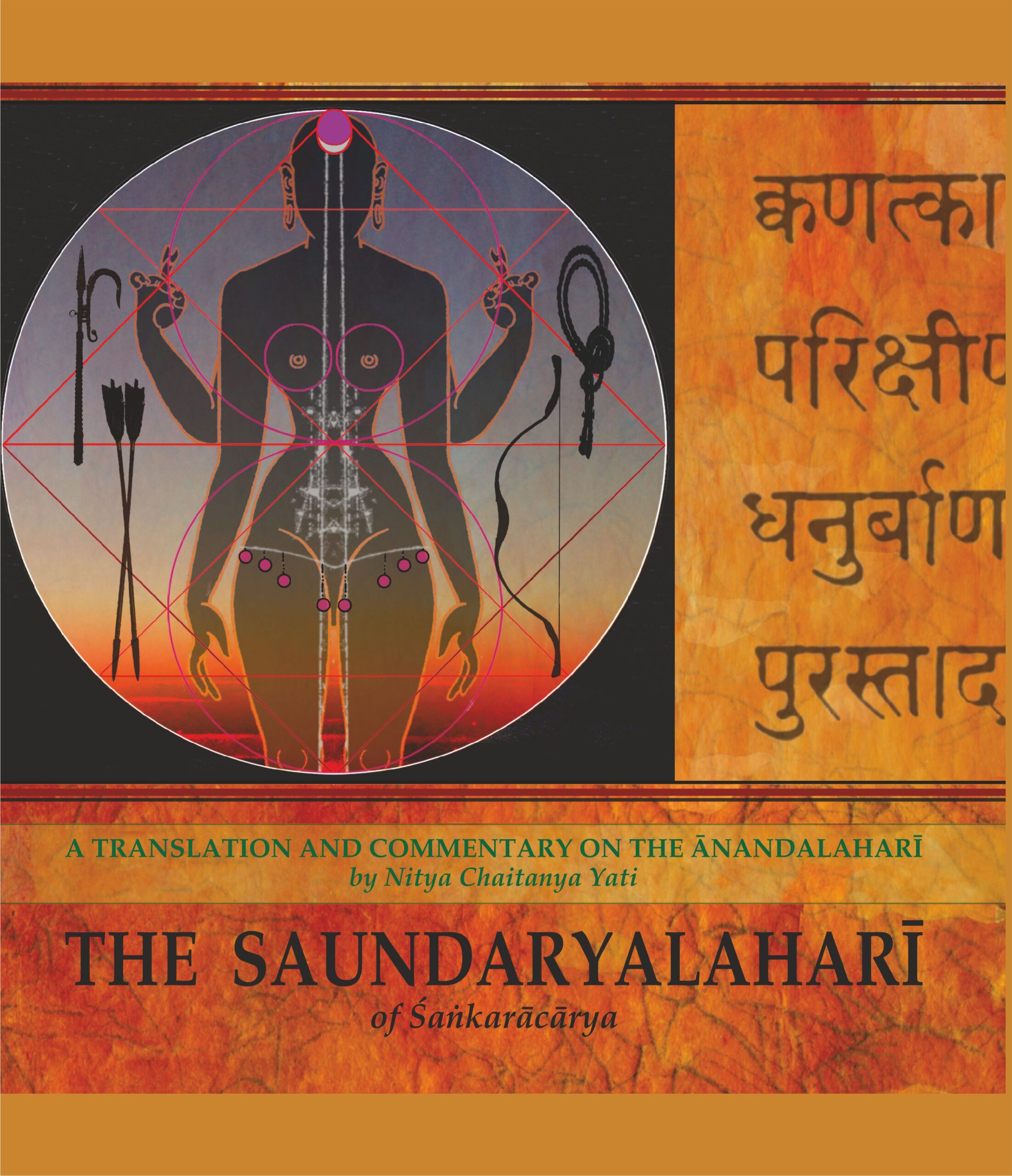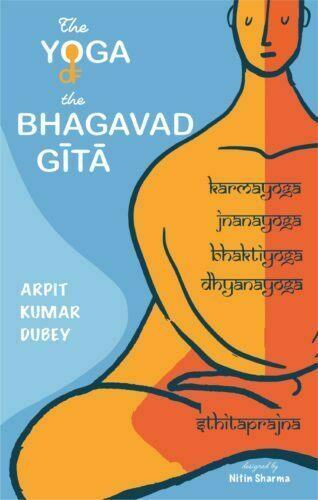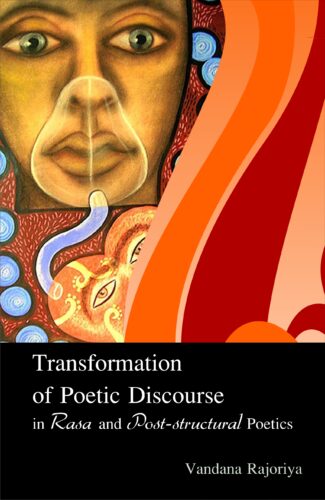Showing 111–120 of 135 results

This book comprises the first part of Saundaryalahari, popularly known as Anandalahari. The text is a protolinguistic composition using a pictorial language of images. The absolute joy of Advaita is presented subjectively as ananda and objectively as saundarya. For the contemplation of the Shri Chakra, 53 meditations have also been provided.
This book comprises the first part of Saundarya Lahari (The Upsurging Billow of Beauty), popularly known as Ananda Lahari, covering the first forty-one verses.
This poetic work has fascinated generations of scholars and laypersons with the sublime beauty of the verses in praise of the Devi, but also puzzled people by the authorship of Shankara. The text is a protolinguistic composition using a pictorial language of images. Beauty, elevated to the highest level, provides content to the otherwise abstract notion of the Absolute. The absolute joy of Advaita is presented subjectively as ananda and objectively as saundarya.
This tenth-century hymn to the Devi is a poetic restatement by the philosopher Shankara of his strict Advaita Vedanta monism. In a compelling series of verses, Shankara draws in many strands of Indias heritage and braids them into a vision of luminous, transcendent Beauty.
The present commentary by Guru Nitya Chaitanya Yati grew out of his class of intimate meditations. He has integrated the academic disciplines of aesthetics, linguistics, and psychology with contemplation into a comprehensive study of creative manifestation. The heterodox Tantric Shri Vidya schools are centered on the realistic worship of the Devi or Goddess and the Shri Chakra. Keeping in line with contemplation, the Appendix provides 53 meditations on the Shri Chakra.

This volume presents the translation and interpretation of thirteen principal Upanisads such as Brhadaranyaka, Chandogya, Taittiriya, Aitareya, Kausitaki, Kena, Katha, Isa, Mundaka, Prasna, Mandukya, Svetasvatara and Maitri along with the outline of the philosophical wisdom inherent in these Upanisads. It also features the recurrent and parallel passages in these principal Upanisads and the Bhagavadgita.
Upanisads are an authoritative compendium of Indian metaphysics. They represent the earnest efforts of profound thinkers of early India to solve the problems of origin, nature, and destiny of man and the universe, more technically the meaning and value of knowing and being. They are replete with sublime conceptions and with intuitions of universal truth. These Upanisads sets forth two opposing theories: one of mundane life and the other relating to a life that is in search of the Supreme Reality and man’s ultimate aim.
Though, traditionally, 108 Upanisads are well known and subject to various studies, there are around 200 Upanisads in toto. Of them, this volume contains the translation and interpretation of thirteen principal Upanisads such as Brhadaranyaka, Chandogya, Taittiriya, Aitareya, Kausitaki, Kena, Katha, Isa, Mundaka, Prasna, Mandukya, Svetasvatara and Maitri along with the outline of the philosophical wisdom inherent in these Upanisads. It also features the recurrent and parallel passages in these principal Upanisads and the Bhagavadgita.
The Ramayana has effected incessantly the Indian consciousness for more 2,500 years. Its moral and ethical impact and relevance are par excellence of its poetic beauty and dramatic narrative. It gave a new praxis to the dharmic mores of the Indian psyche. The Valmiki Ramayana as Epic and Dharmasastra: Reading the adikavya as an Ethical Guide is derived from a series of three lectures that Prof. Dr Robert Goldman delivered at the Department of Philosophy, Jadavpur University in 2016 as a visiting professor.
The book, while taking an overview of the Sanskrit epics as poetry, history and science, takes one through the dilemma that Dasaratha faces due to his denying kingdom to Rama and the latter’s going for vanavasa, the ethical and moral challenges that Rama faces in his war with Ravana and others, and in the ethical shift that Rama undergoes from his compassionate and self-sacrificing moral code to a more rigid dharmasastra and arthasastra-oriented mode of royal conduct in the last part of the epic. All this, looking back over the various situations, episodes and responses of the principal characters in the epic drama.
The Ramayana thus functions not only as as a grand kavya and an ithihasa, but also as a dharmasastra and a nitisastra as well.

It vividly and graphically presents the key concepts of the Bhagavadgita while majorly discussing the concepts like atman, Paramatman, jagat, karma-yoga, jnana-yoga, bhakti-yoga, dhyana-yoga, sthitaprajna, sadhakas’ challenges and the ways out.
This volume covers all the aspects of Yoga and self-management discussed in the Bhagavadgita –– a comprehensive text of personal and professional life management and adhyatma-sadhana (spiritual upgradation). What makes the book special is its dialogue format between a guru and his disciple as exactly what we witness in the Bhagavadgita as between Sri Krsna and Arjuna.
It vividly and graphically presents the key concepts of the Bhagavadgita while majorly discussing the concepts like karma-yoga, jnana-yoga, bhakti-yoga, dhyana-yoga, sthitaprajna, and seven keys of self upgradation, which leads towards Health, Happiness and Harmony, challenges and the ways out.
This book will help in the making broader understanding of the concepts and philosophy of the Bhagavadgita, which transcends time and space, to register with the new generation readers and thereby emulate and practise the varied forms of Yoga.
The Bṛhadāraṇyaka Upaniṣad is the earliest text in its genre, inaugurating the entire history of Indian philosophy. Commented on by numerous teachers of Vedantic schools, its fertility is not exhausted by any or all of them. Unlike later philosophy, it is not a work of explanation but of contemplative praxis towards cosmic and nondual self-realization. Locating it in a countercultural movement and relating it to the ontological vision of Sri Aurobindo, Time-Steps of the Cosmic Horse is a sustained contemplation on the first chapter of this Upaniṣad drawing attention to the phenomenology and rhetorical structure of its linguistic action.
| Tirumurai is the sacred poetry in the Saiva tradition of ancient Tamilnadu. Sung to the rhythm of percussion, string and reed instruments, the devotional outpouring of saints and poets known as Nayanars of the fifth to the twelfth century CE reflect the religious and cultural mores of the people. This book attempts to capture the grandeur of this vast, fascinating subject by presenting a detailed overview of the salient features. Beginning with an introduction to Nataraja Tattvam and Tamil Isai, all twelve Tirumurai are explained. Each chapter begins with the life story of the Nayanar followed by an analysis of the poetry with explanation of paN (raga) and sthala puranam. A few select songs from each Tirumurai are presented in the original Tamil with Romanized transliteration as well as English translation, made available in an online audio album complementing this book. Foreword by Lakshmi Viswanathan |

This work is a dedicated effort at defining rasa and post-structuralist theories in clear and graphical terms while focusing on intercultural application of these theories by applying rasa to canonical English poems and post-structuralism Western theories to classical Sanskrit works.
Rasa, the Indian literary theory, and the post-structuralism, the Western literary theory, constitute two important areas of study in literary criticism and literature. This volume tries to define rasa and post-structuralist theories in clear and graphical terms. It focuses on inter-cultural application of these two classical theories. This involves the attempt to apply the Indian literary theory of rasa to canonical English poems including those of the epic stature like Dantes Divine Comedy and John Miltons Paradise Lost. It also applies the Western literary theory of post-structuralism, those of Derrida, Lacan and Foucault, to canonical works of Sanskrit poetry like Bhartrharis Shringarashataka, Shudrakas Mrcchakatika, Dandins Dashakumaracarita and Mudrarakshasa of Vishakhadatta among others.
The comparative study that involves a deep and engrossing study of various situations in the epics and other works, unfolds the uniqueness of the latter. It reveals the similarities in the two theories such as their goal of generation of value, quite realistically. It discusses the distinction in the rasa and post-structuralist formations, such as the idea of communication being one of the important principles of the conceptualisation of form and structure of rasa, while the art of communication is not so evolved in post-structuralism.
The structure of the study is planned in a sequential order to enable readers to easily understand the theories and their application. The book is bound to be useful to scholars and students of Indology, particularly Indian literature and literary criticism, and those interested in cross-cultural studies in this field.

This English version of Vicaracandrodaya elucidates the basic concepts of Advaita Vedanta as a dialogue between a guru and his disciple. A true knowledge seeker who studies this text under a brahmanistha guru will get to know the secrete knowledge of Vedanta. Also, it is a ready reference to the basic concepts in Pancadasi of Vidyaranya and Vicarasagara of Niscaladasa.
A prakarana in old Hindi (one of the regional mixed dialects), Vicaracandrodaya elucidates the basic concepts of Advaita Vedanta in the form of questions and answers. Pandit Pitambar, the author of the text, presents this work as a dialogue between a guru and his disciple. This book is an English translation of Vicaracandrodaya, by S. Bhuvaneshwari. It is spread across 249 questions and their answers, and takes the reader into the essence of the entire Vedantashastra. It also has a Laghu-vedanta-kosha explaining the basic Vedantic terms and a chapter as index providing quick reference to the basic concepts of Advaita Vedanta.
The author enunciates that a true knowledge seeker who studies this text under a brahmanishtha guru will get to know the secrete knowledge of Vedanta. And this knowledge will dispel darkness from his mind as the rising moon dispels darkness from the world. However, he insists that it should be studied from a guru with shraddha as Vedanta cannot be grasped without the guidance of an enlightened teacher. Also, this book serves as a ready reference to the basic concepts as discussed in Pancadashi of Vidyaranya and Vicarasagara of Nishcaladasa.
This volume is both a guide to the beginners in Vedanta and a text for nididhyasana. It will benefit all the people who dwell in the domain of Vedanta.

This English version of Vicaracandrodaya elucidates the basic concepts of Advaita Vedanta as a dialogue between a guru and his disciple. A true knowledge seeker who studies this text under a brahmanistha guru will get to know the secrete knowledge of Vedanta. Also, it is a ready reference to the basic concepts in Pancadasi of Vidyaranya and Vicarasagara of Niscaladasa.
A prakarana in old Hindi (one of the regional mixed dialects), Vicaracandrodaya elucidates the basic concepts of Advaita Vedanta in the form of questions and answers. Pandit Pitambar, the author of the text, presents this work as a dialogue between a guru and his disciple. This book is an English translation of Vicaracandrodaya, by S. Bhuvaneshwari. It is spread across 249 questions and their answers, and takes the reader into the essence of the entire Vedantashastra. It also has a Laghu-vedanta-kosha explaining the basic Vedantic terms and a chapter as index providing quick reference to the basic concepts of Advaita Vedanta.
The author enunciates that a true knowledge seeker who studies this text under a brahmanishtha guru will get to know the secrete knowledge of Vedanta. And this knowledge will dispel darkness from his mind as the rising moon dispels darkness from the world. However, he insists that it should be studied from a guru with shraddha as Vedanta cannot be grasped without the guidance of an enlightened teacher. Also, this book serves as a ready reference to the basic concepts as discussed in Pancadashi of Vidyaranya and Vicarasagara of Nishcaladasa.
This volume is both a guide to the beginners in Vedanta and a text for nididhyasana. It will benefit all the people who dwell in the domain of Vedanta.

This work presents a study of the twelve principal Upanisads, thus unfolding the spirit and substance of Upanishadic thought. It offers the text of the Upanisads in Devanagari and its translation in English along with detailed notes incorporating the commentaries of prominent spirit-ual thinkers and teachers including Sankaracarya and Sankarananda.
The Upanishads are perhaps one of the oldest philosophical treatises concerned with the mystery of the Absolute. This work (in three volumes) presents a study of the twelve principal Upanishads , thus unfolding the spirit and substance of Upanishadic thought. Written in a lucid style, it offers the text of the Upanishads in Devanagari and its translation in English along with detailed noted incorporating the commentaries of prominent spiritual thinkers and teachers including Shankaracarya and Shankaranand. The authors, scholars who have put in years of intense study on the subject, here offer a fresh approach and new insights into the philosophy of absolute unity as taught by the Upanishads and its quest for answers to abstruse questions like the origin of the universe, the nature of deity and the soul, and connection of mind and matter. The volumes are a must for scholars of Indian philosophy as well as students, and especially those genuine aspirants who wish to achieve moksha by the process of yoga for moksha is not possible without understanding the meaning of the Upanishads.
| × |
|
Amulets and Pendants in Ancient Maharashtra (3rd c. bc to 3rd c. ce) 1 x ₹198.00 |
| × |
|
Ancient Movements of Indo-Aryans and Indo-Aranians 1 x ₹585.00 |
| × |
|
Integration of Endogenous Cultural Dimension into Development 1 x ₹504.00 |
| × |
|
Recent Responses to the Philosophy of Wittgenstein 1 x ₹5,130.00 |
| × |
|
1000 Full Moons 1 x ₹625.00 |
| × |
|
Sri Brihaspati Vrata Katha 1 x ₹45.00 |
| × |
|
Why I Am an Indian and Other Essays 1 x ₹2,160.00 |
| × |
|
Mundaka Upanisad 1 x ₹126.00 |